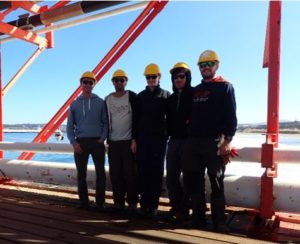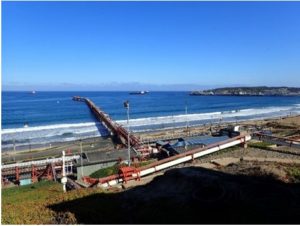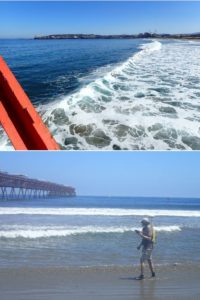The second WASH experiment was successfully completed in Quintero, Chile between November 21-28, 2016. The main part of the project team consisted of Dr Chris Blenkinsopp, Erwin Bergsma and Kévin Martins (Bath), José Beya (Universidad de Valparaiso, Chile), Hannah Power (University of Newcastle, Australia) and Roberto Agredano Martín (Pontificia Universidad Católica de Chile). We were also ably supported at times by Anne Quaas, Francisca Quijada and Harold Diaz - students from Universidad de Valparaíso and Universidad Técnica Federico Santa María.
The study site at Quintero was quite a contrast to Saltburn as it is home to a wide range of heavy industry. The beach is exposed to consistent large swells from the Pacific and it was the opportunity to measure consistent, large breaking waves that led us to choose this site. To mount the Lidar instruments for our experiment, we were very kindly granted access to utilise the 750 m long loading jetty of Oxiquim S.A.
Wave conditions during the experiment were very consistent throughout the experiment, with wave breaking height around 2m. The wind was generally light every morning making this the ideal time to focus our efforts and hence necessitating some early rises.
The experimental setup was similar to that at Saltburn, with 3 Lidar instruments deployed at 30 m intervals along the jetty, approximately 7 m above the mid tide water level. A monitoring camera was installed on the hill behind the beach to monitor run-up processes, beach changes and potentially provide the opportunity to estimate nearshore bathymetry using a depth-inversion type approach. Additionally, two ADCPs were deployed in 18 m water depth – one owned by Oxiquim which recorded spectral parameters and another installed with the help of the Chilean Navy specifically for the project which recorded time-series data. GPS beach surveys were completed every low tide, along with wading total station surveys to get surf zone profiles, backed up by rope soundings from the jetty itself.
The installation of in-situ instrumentation on the beach was limited by the fact that the tidal range at the site is only 1.8 m and thus to install surf zone instruments would require a boat which was not possible in the wave conditions. A swash zone ADV and pressure transducer were deployed on a scaffold frame every low tide with the aim of obtaining measurements during high tide.
Overall, the experiment was a great success, bringing together scientists from 3 continents to obtain some truly unique measurements. We were aided by significantly warmer weather than for our Saltburn experiment and consistently good wave conditions with light winds. As well as providing our project with great data, we were very lucky to get the opportunity to visit Chile, eat too many avocados and attempt some very poor Spanish.
Huge thanks must go to Erwin, who was thrown straight into organising most of the instrumentation and logistics from Bath. Our hosts, Oxiquim were fantastically helpful throughout the experiment, in particular Marcelo Gomez who went out of his way to assist us with support from boats, divers and welders. Most of all thanks go to Jose Beya whose help with translating, organising logistics and also arranging a very well attended post-experiment seminar made the whole experiment possible.
Respond




